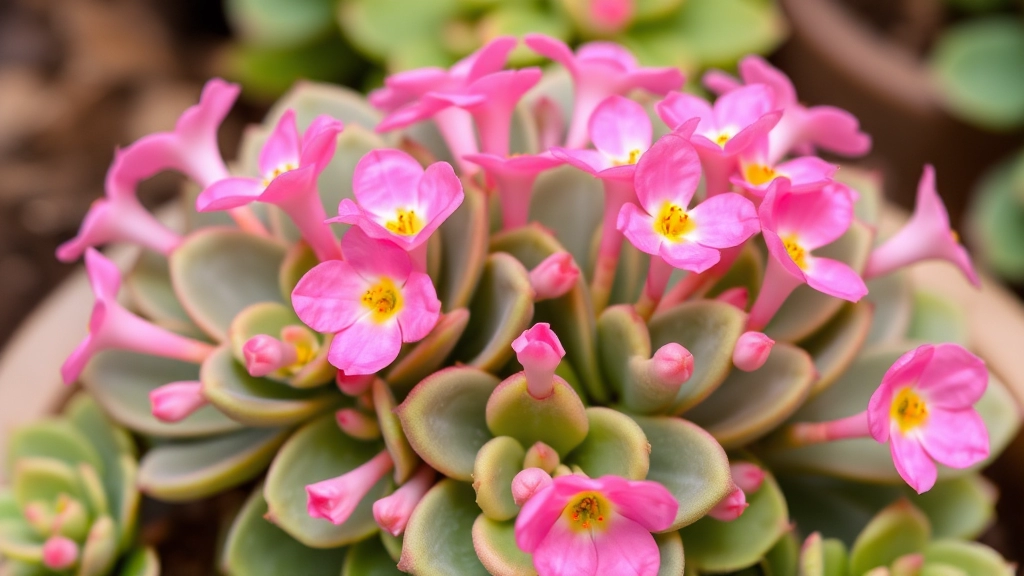Captivated by Kalanchoe Succulents
Are you captivated by the vibrant charm of a Kalanchoe succulent with pink flowers? You’re not alone. These stunning plants, including varieties like Kalanchoe blossfeldiana and Kalanchoe ‘Pink Butterflies,’ are popular for their striking blooms and easy care. Whether you’re a seasoned gardener or a succulent newbie, understanding their unique needs can help you cultivate a thriving pink-flowered kalanchoe.
Exploring Different Varieties
First, let’s explore the different varieties of kalanchoe with pink flowers. From the classic Kalanchoe blossfeldiana to the whimsical Kalanchoe ‘Pink Butterflies,’ each offers a unique appeal. Knowing the specific variety you have can guide your care routine, ensuring your plant thrives and blooms beautifully. Ready to dive in? Let’s get started!
Different Varieties of Kalanchoe With Pink Flowers
When it comes to Kalanchoe, the vibrant pink flowers can be a delightful addition to any garden or indoor space. But which varieties should you consider?
Popular Varieties
- Kalanchoe blossfeldiana
- This is perhaps the most well-known variety, boasting clusters of small, bright pink flowers.
- It blooms in cycles, often producing flowers multiple times a year.
- Kalanchoe luciae
- Also known as the “Paddle Plant,” it features stunning pink edges on its leaves.
- While its flowers are less prominent, the pink-tinted foliage is a beautiful sight.
- Kalanchoe thyrsiflora
- This variety produces tall flower spikes adorned with pink blooms.
- It’s a robust plant that thrives well in various conditions.
- Kalanchoe ‘Pink Butterflies’
- A hybrid known for its unique shape and vibrant pink flowers.
- It’s an excellent choice for both indoor and outdoor gardening.
These varieties not only add a splash of colour but also bring a sense of joy and warmth to your surroundings. For more information on how to care for these beautiful plants, check out our complete care guide for Kalanchoe blossfeldiana. Additionally, if you are interested in the health benefits of Kalanchoe, don’t miss our article on the health benefits of Kalanchoe pinnata leaf extract.
Ideal Growing Conditions for Kalanchoe Succulents
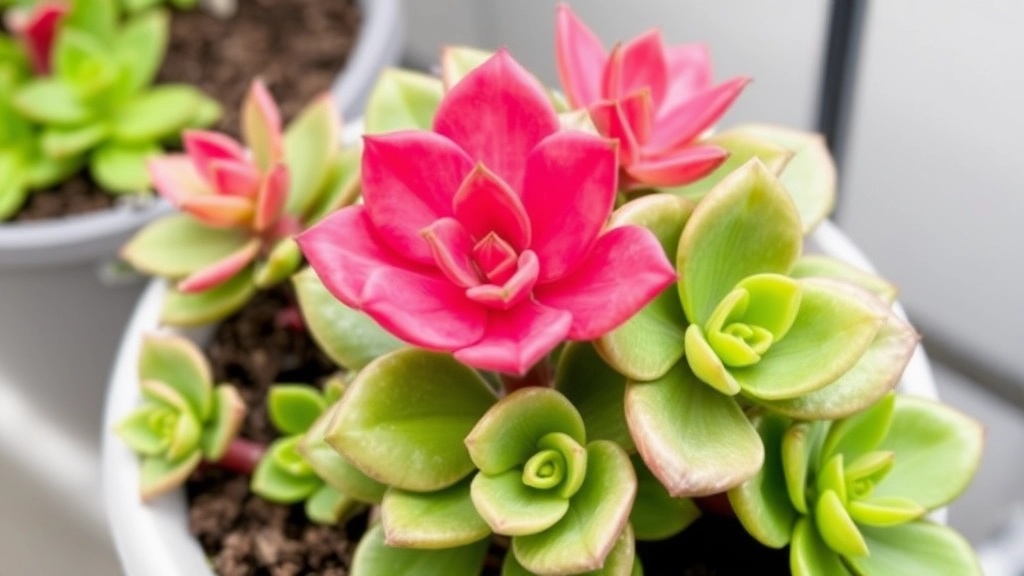
So, you’ve got your eye on some beautiful Kalanchoe succulents with pink flowers, but you’re wondering what they need to thrive.
Let’s dive into the ideal growing conditions that will keep your Kalanchoe happy and healthy.
Light
Kalanchoe loves bright light!
- Direct sunlight: Aim for at least 6 hours a day.
- Indoors?: A south-facing window is your best bet.
- Too little light?: You’ll notice leggy growth—time to move them!
Temperature
These little beauties prefer a warm environment.
- Ideal range: 20-25°C (68-77°F) during the day.
- Nighttime chill: They can tolerate cooler temps, but keep it above 10°C (50°F).
- Frost alert: Kalanchoe is not a fan of frost, so protect them during chilly months.
Humidity
Kalanchoe thrives in low humidity.
- Dry air: They’re perfect for those of us in drier climates.
- Avoid damp spots: Too much moisture can lead to rot.
Air Circulation
Good airflow is crucial.
- Avoid overcrowding: Give them space to breathe.
- Ventilation: This helps prevent fungal issues.
When it comes to nurturing Kalanchoe succulents, understanding their light and temperature needs is crucial. Have you ever wondered why your Kalanchoe isn’t blooming or thriving? The right conditions can make all the difference.
### Light Requirements
Kalanchoe plants thrive in bright, indirect sunlight. Here’s what you need to know:
– **Optimal Light**: Aim for 6 hours of bright light daily.
– **Direct Sunlight**: A little is okay, but too much can scorch the leaves.
– **Indoor Placement**: A south-facing window is ideal for indoor plants.
If your Kalanchoe is stretching or leaning towards the light, it’s a sign it’s not getting enough. For more detailed care tips, check out this [complete guide for Kalanchoe Tomentosa](https://planthq.org/how-to-care-for-kalanchoe-tomentosa-complete-guide/).
### Temperature Requirements
Kalanchoe prefer warm conditions, making them perfect for indoor settings. Consider these points:
– **Ideal Temperature**: Between 18°C to 24°C (65°F to 75°F).
– **Nighttime Chill**: They can tolerate cooler temperatures, but not below 10°C (50°F).
– **Avoid Drafts**: Keep them away from cold drafts or sudden temperature changes.
Maintaining these light and temperature conditions will help your Kalanchoe flourish and bloom beautifully. For more on ensuring your plant thrives, visit the [ideal temperature for Kalanchoe Blossfeldiana growth](https://planthq.org/ideal-temperature-for-kalanchoe-blossfeldiana-growth/).
How to Water and Fertilize Kalanchoe Succulents
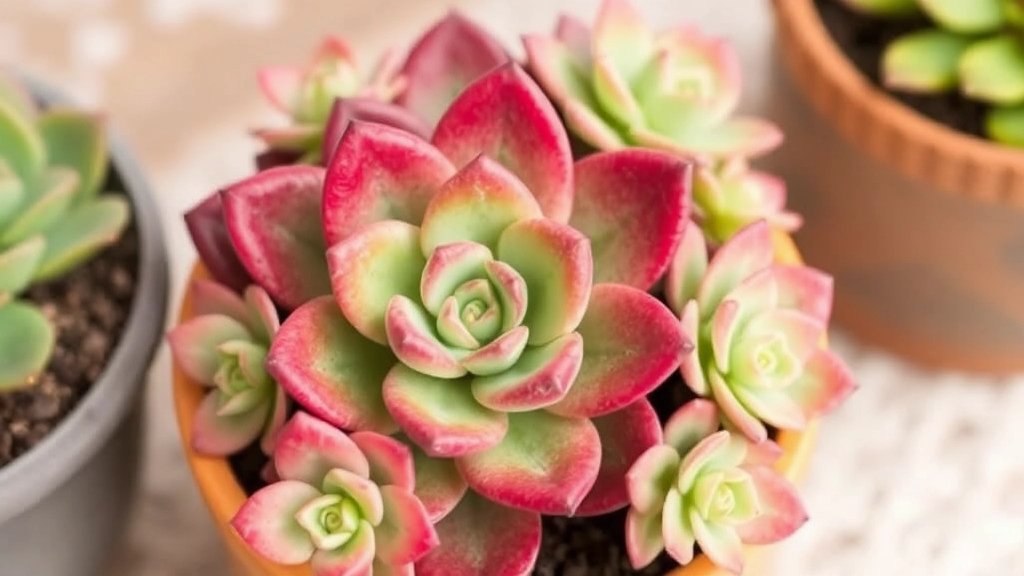
When it comes to caring for Kalanchoe succulents, one of the most common concerns is how to properly water and fertilize them. Overwatering is a frequent mistake that can lead to root rot, while under-watering can stunt their growth. Understanding the balance is crucial for vibrant, healthy plants.
Watering Guidelines
- Frequency: Water your Kalanchoe when the top inch of soil feels dry. This typically translates to every 2-3 weeks, but it can vary based on your environment.
- Method: Use the soak-and-dry method. Water thoroughly until it drains from the bottom, then allow the soil to dry completely before the next watering.
- Signs of Overwatering: Yellowing leaves, mushy stems, and a musty smell are indicators that you might be overdoing it.
- Signs of Underwatering: If the leaves are wrinkled or shriveled, it’s time for a drink.
Fertilizing Tips
- Type of Fertilizer: Opt for a balanced, water-soluble fertilizer, ideally one formulated for succulents.
- Frequency: Fertilize every 4-6 weeks during the growing season (spring and summer). Reduce or stop during the dormant months (fall and winter).
- Dilution: Always dilute the fertilizer to half strength to avoid burning the roots.
- Timing: Apply fertilizer after watering to prevent root shock.
Propagation Methods: From Cuttings, Offsets, and Seeds
As we explore the care and growth of Kalanchoe, understanding how to propagate these beautiful succulents can elevate your gardening experience. Propagation not only allows you to expand your collection but also gives you the joy of nurturing new plants.
1. Propagation from Cuttings
- Select a Healthy Stem: Choose a stem that is healthy and free from disease.
- Cut the Stem: Use a clean, sharp knife to cut a 10-15 cm section.
- Let it Callous: Place the cutting in a dry area for a few days until the cut end callouses over.
- Plant in Soil: Once calloused, plant the cutting in well-draining soil, burying it about an inch deep.
- Water Sparingly: Water lightly and place in bright, indirect light.
2. Propagation from Offsets
Offsets are small plantlets that grow at the base of the parent plant. This method is straightforward and effective.
- Identify Offsets: Look for small rosettes at the base of the main plant.
- Gently Remove: Carefully twist or cut the offset away from the parent plant.
- Let it Dry: Allow it to dry for a day or two to prevent rot.
- Plant in Soil: Place the offset in a pot with succulent soil.
- Water Lightly: Water it sparingly until it establishes roots.
3. Propagation from Seeds
While less common, seed propagation can be rewarding and offers a chance to grow unique varieties.
Common Problems and Solutions in Growing Kalanchoe
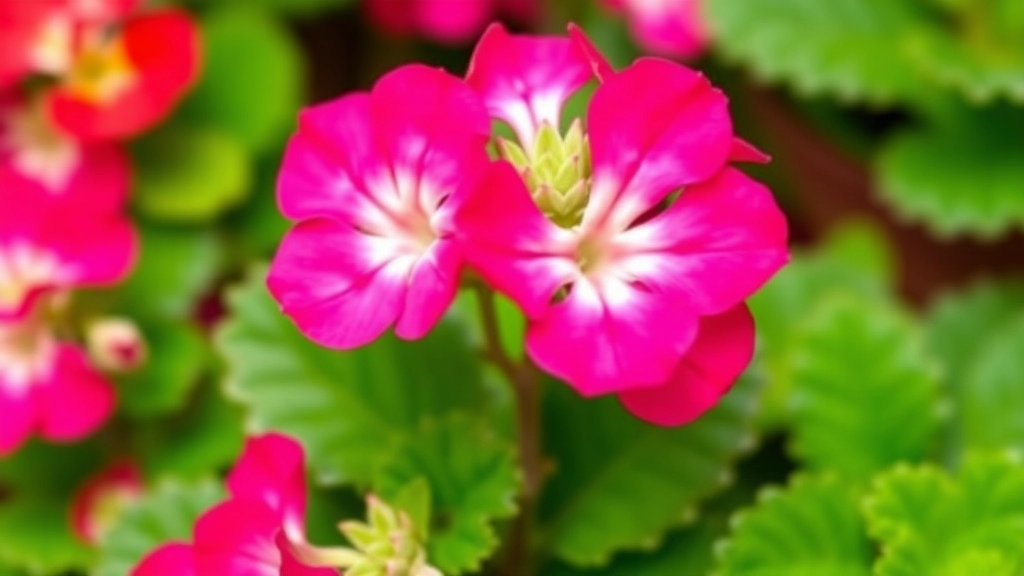
So, you’ve got your Kalanchoe all set up, and now you’re wondering why it’s not thriving like you hoped.
Let’s dive into some common issues you might encounter and how to tackle them.
1. Overwatering
Problem: Kalanchoes are succulents, which means they don’t need a lot of water. Overwatering can lead to root rot.
Solution:
- Check the soil: Make sure it’s dry at least an inch down before watering.
- Use well-draining pots: Terracotta pots are great as they allow moisture to escape.
2. Underwatering
Problem: On the flip side, underwatering can also be a problem. Your Kalanchoe will start drooping if it’s thirsty.
Solution:
- Water regularly: During the growing season, water every 2-3 weeks.
- Signs of thirst: Leaves may become wrinkled or shrivelled.
3. Pest Infestations
Problem: Mealybugs and aphids love to munch on Kalanchoe leaves.
Solution:
- Inspect regularly: Check the undersides of leaves.
- Use neem oil: A natural pesticide that can help eliminate pests.
4. Poor Lighting
Problem: If your Kalanchoe isn’t getting enough light, it might become leggy or stop blooming.
Solution:
- Bright, indirect sunlight: Aim for 6 hours a day.
- Rotate your plant: This helps it grow evenly.
5. Temperature Fluctuations
Problem: Kalanchoes prefer a stable environment. Too cold or too hot can stress them out.
Solution:
- Ideal range: Keep them between 15°C to 25°C.
- Avoid drafts: Keep them away from windows and doors that open frequently.
6. Nutrient Deficiency
Problem: If your Kalanchoe isn’t blooming, it might need a nutrient boost.
Solution:
- Fertilize sparingly: Use a balanced, diluted fertiliser during the growing season.
- Watch for yellowing leaves: This can indicate a lack of nutrients.
Best Soil Types for Healthy Kalanchoe Growth
When it comes to nurturing your Kalanchoe, the right soil is crucial. You might be wondering, âWhat kind of soil does my Kalanchoe need to thrive?â
Soil Composition
Kalanchoe succulents prefer well-draining soil to prevent root rot. Here are some ideal soil options:
- Cactus Mix: Specifically formulated for succulents, this mix allows excess water to drain away quickly.
- Perlite or Pumice: Adding these materials improves aeration and drainage, making them excellent for Kalanchoe.
- Homemade Mix: Combine equal parts of potting soil, sand, and perlite for a custom blend.
pH Level
Kalanchoe thrives in slightly acidic to neutral soil, ideally with a pH of 6.0 to 7.0. Testing your soil can help you maintain the right balance.
Container Considerations
Ensure your pot has drainage holes. This prevents water from pooling at the bottom, which can lead to root issues.
Common Mistakes
Avoid heavy, clay-based soils that retain moisture. These can suffocate the roots and hinder growth. For more detailed guidance on growing and caring for Kalanchoe, check out our complete care guide for Kalanchoe Tomentosa and our tips on optimal care for Kalanchoe Blossfeldiana growth.
Encouraging Kalanchoe to Bloom Indoors and Outdoors
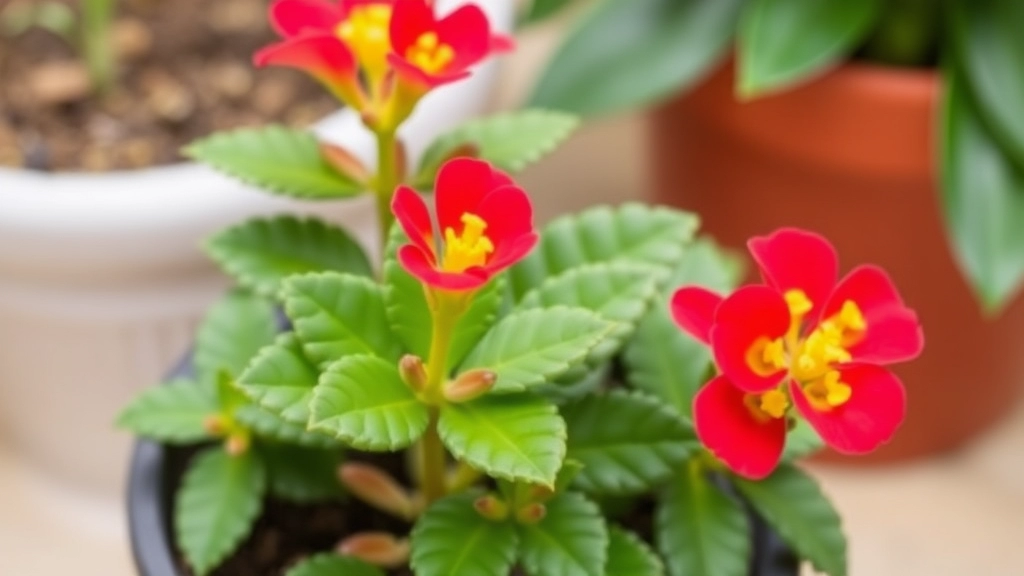
So, you’ve got your Kalanchoe, and you’re itching to see those stunning pink flowers pop.
But maybe you’re wondering, “What do I need to do to coax them into bloom?”
It’s a common concern for many plant lovers, and thankfully, there are some straightforward ways to encourage your Kalanchoe to show off its flowers.
1. Light Matters
- Bright, Indirect Sunlight: Kalanchoe thrives in bright light.
- Avoid Direct Sun: Too much direct sunlight can scorch those lovely leaves.
2. Temperature Control
- Warmth is Key: Keep your Kalanchoe in a warm spot, ideally between 18-24°C.
- Watch for Chills: Sudden drops in temperature can stress the plant and delay blooming.
3. Watering Wisely
- Let It Dry: Allow the soil to dry out between waterings.
- Don’t Overdo It: Too much water can lead to root rot, which is a surefire way to stop those blooms in their tracks.
4. Fertilising Right
- Use a Balanced Fertiliser: A diluted, balanced fertiliser every few weeks during the growing season can work wonders.
- Cut Back Before Blooming: Stop fertilising a month before you expect blooms to encourage flower production.
5. Pruning for Performance
- Pinch Off Spent Flowers: Regularly deadhead spent blooms to promote new growth.
- Trim for Shape: Light pruning can encourage bushier growth, leading to more flowers.
6. Stress for Success
- Shorten Daylight Hours: Kalanchoe is a short-day plant, meaning it needs longer nights to trigger blooming. Consider keeping it in darkness for about 14 hours a day for a few weeks.
7. Patience is a Virtue
- Time and Care: Sometimes, all it takes is a bit of time and consistent care.
Tips for Repotting and Pruning Kalanchoe
As we explore the care of Kalanchoe succulents, it’s essential to address how repotting and pruning can significantly enhance their growth and vitality.
When to Repot Kalanchoe
- Signs of Repotting: If you notice roots emerging from the drainage holes or the plant has outgrown its pot, it’s time to repot.
- Best Time: Early spring is ideal, just before the growing season begins.
Steps for Successful Repotting
- Choose the Right Pot: Select a pot that is slightly larger than the current one, with good drainage holes.
- Prepare the Soil: Use a well-draining soil mix, such as a cactus or succulent blend. For more information, check out the best soil for Kalanchoe Blossfeldiana care tips.
- Remove the Plant: Gently take the Kalanchoe out of its pot, being careful not to damage the roots.
- Inspect the Roots: Trim any dead or rotting roots with clean scissors.
- Place in New Pot: Position the plant in the centre of the new pot and fill with soil, ensuring the base of the plant is level with the soil surface.
- Water Sparingly: After repotting, wait a week before watering to allow the roots to recover.
Pruning for Health and Shape
Pruning is vital for maintaining the shape and health of your Kalanchoe.
- When to Prune: The best time to prune is during the growing season, typically in spring or early summer.
- What to Prune:
- Remove dead or yellowing leaves.
- Trim back leggy growth to encourage a bushier shape. For detailed pruning tips, visit our guide on how to propagate Kalanchoe Blossfeldiana cuttings.
- Cut off spent flowers to promote new blooms.
Pruning Steps
- Gather Tools: Use clean, sharp scissors or pruning shears.
- Identify Areas to Cut: Focus on areas that look unhealthy or overgrown.
- Make Clean Cuts: Cut just above a leaf node to encourage new growth.
- Dispose of Debris: Clear away any cuttings to prevent pests.
FAQs About Kalanchoe Succulent With Pink Flowers
What are the ideal growing conditions for Kalanchoe succulents?
Kalanchoe succulents thrive in bright light, warm temperatures, low humidity, and good air circulation. Aim for at least 6 hours of direct sunlight daily, keep the temperature between 20-25°C (68-77°F) during the day, and ensure the environment is well-ventilated.
How often should I water my Kalanchoe succulent?
Water your Kalanchoe when the top inch of soil feels dry, typically every 2-3 weeks. Use the soak-and-dry method: water thoroughly until it drains from the bottom, then allow the soil to dry completely before the next watering.
What type of fertilizer is best for Kalanchoe succulents?
Opt for a balanced, water-soluble fertilizer, ideally one formulated for succulents. Fertilize every 4-6 weeks during the growing season (spring and summer) and reduce or stop during the dormant months (fall and winter). Always dilute the fertilizer to half strength to avoid burning the roots.
What are common problems with Kalanchoe succulents and how can I solve them?
Common issues include overwatering, underwatering, pest infestations, poor lighting, temperature fluctuations, and nutrient deficiencies. Solutions range from adjusting your watering schedule to ensuring proper light and temperature conditions, using neem oil for pests, and fertilizing sparingly.
How can I encourage my Kalanchoe to bloom?
To encourage blooming, ensure your Kalanchoe gets bright, indirect sunlight, keep it in a warm spot, water wisely, use a balanced fertilizer, prune regularly, and consider shortening daylight hours to trigger blooming. Patience and consistent care are also key.
Can Kalanchoe succulents tolerate low temperatures?
Kalanchoe succulents prefer a warm environment but can tolerate cooler temperatures down to 10°C (50°F). However, they are not frost-tolerant, so protect them during chilly months.
What should I do if my Kalanchoe succulent has leggy growth?
Leggy growth typically indicates insufficient light. Move your Kalanchoe to a brighter location, preferably one that gets at least 6 hours of direct sunlight daily. Indoors, a south-facing window is ideal.
How do I deal with pest infestations on my Kalanchoe succulent?
Inspect your Kalanchoe regularly for pests like mealybugs and aphids, especially on the undersides of leaves. Use neem oil, a natural pesticide, to eliminate pests. Ensure good air circulation to prevent infestations.
Is it necessary to prune Kalanchoe succulents?
Yes, regular pruning can help promote bushier growth and more flowers. Pinch off spent flowers and trim for shape to encourage new growth. This practice also helps maintain the plant’s overall health.
How can I tell if I am overwatering or underwatering my Kalanchoe?
Signs of overwatering include yellowing leaves, mushy stems, and a musty smell. Signs of underwatering include wrinkled or shriveled leaves. Adjust your watering schedule based on these indicators.
References
-
Kalanchoe Plant Care: How To Grow Kalanchoe
-
How to Grow Kalanchoe
-
Kalanchoe: How to Plant, Grow, and Care for Kalanchoe
